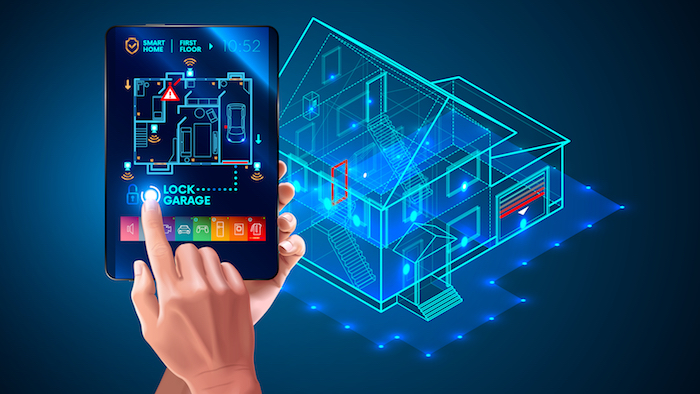Introduction
Imagine walking into your house after a long day and the lights turn on automatically. Your thermostat has already adjusted to your preferred temperature, your favorite playlist starts playing softly in the background, and your robot vacuum is finishing its last sweep. No, this isn’t a sci-fi movie—it’s the reality of a smart home.
Smart homes are no longer futuristic fantasies. They’re increasingly becoming mainstream, offering homeowners greater convenience, efficiency, and security. But what exactly is a smart home? How does it work? And is it worth investing in one? Let’s break it all down.
What is a Smart Home?
A smart home is a residence equipped with devices that can be controlled remotely via a smartphone, tablet, or voice assistant. These devices are connected through the internet—this network is often referred to as the “Internet of Things” (IoT).
From lighting and security to entertainment and kitchen appliances, smart home technology allows you to automate and control various aspects of your living environment. In short, a smart home integrates technology into your daily life, making it more responsive, efficient, and customizable.
Key Components of a Smart Home
A smart home can be as simple or complex as you like. Here are the most common components:
1. Smart Lighting
Smart bulbs like Philips Hue or LIFX can change color, dim, or switch off at scheduled times. You can control them with apps or voice assistants like Alexa or Google Assistant.
2. Smart Thermostats
Devices like Nest or Ecobee learn your habits and adjust your home’s temperature accordingly. They can save you money on energy bills by optimizing heating and cooling.
3. Smart Security Systems
From video doorbells (e.g., Ring) to motion sensors and smart locks, these systems keep your home safe and let you monitor it from anywhere.
4. Smart Appliances
Fridges that track groceries, ovens you can preheat from your phone, and washers that text you when the laundry’s done—yes, all real.
5. Smart Speakers & Hubs
Amazon Echo, Google Nest, or Apple HomePod serve as control centers. They can manage multiple devices with voice commands or routines.
6. Smart Plugs and Switches
These allow you to control traditional appliances like coffee makers or lamps, giving “dumb” devices a smart edge.
How Does a Smart Home Work?
Smart devices communicate over Wi-Fi, Bluetooth, Zigbee, or Z-Wave. You can control them through:
- Mobile Apps (like SmartThings, HomeKit, or Google Home)
- Voice Commands (using Alexa, Siri, or Google Assistant)
- Automation Routines (like “Good Morning” scenes that turn on lights, start the coffee maker, and raise blinds)
Many homes use a central hub or app to connect and control all smart devices from one place. Over time, these devices can “learn” your preferences and automate tasks without manual input.
Benefits of a Smart Home
1. Convenience
Control everything from your phone or with your voice—even when you’re not home.
2. Energy Efficiency
Smart thermostats, lights, and appliances can reduce energy usage, helping the environment and your wallet.
3. Enhanced Security
Monitor your home in real time, get instant alerts, and control locks and cameras remotely.
4. Customization
Set scenes or routines that align with your lifestyle—like “Movie Night” or “Bedtime.”
5. Accessibility
Smart homes are game-changers for people with disabilities, allowing easier control of their environment.
Common Concerns
1. Privacy
Smart devices collect data to function well. Be sure to read privacy policies and secure your network with strong passwords and two-factor authentication.
2. Compatibility
Not all devices work seamlessly together. It’s best to choose a platform (like Google, Apple, or Amazon) and stick with it for consistency.
3. Cost
While prices are dropping, a fully integrated smart home setup can still be costly. However, you can start small and expand over time.
How to Start Building Your Smart Home
You don’t need to go all-in from day one. Here’s a simple step-by-step approach:
- Choose a Voice Assistant or Platform: Decide between Alexa, Google Assistant, or Siri/HomeKit.
- Start Small: Try a smart bulb or plug to get comfortable.
- Pick a Central Hub (if needed): Some devices need a hub like SmartThings, while others work standalone.
- Add Devices Gradually: Prioritize based on needs—lighting, security, or energy savings.
- Automate: Set up routines and enjoy the magic of automation.
FAQs
Q1: Can I turn my existing home into a smart home?
Absolutely! You don’t need a new house. Start with a smart plug or bulb and build from there.
Q2: Do I need internet access?
Yes. Most smart devices require an internet connection to function, especially for remote control features.
Q3: Is it difficult to install smart devices?
Many smart devices are plug-and-play or install with basic DIY skills. Some, like smart thermostats or door locks, might require a professional.
Q4: Are smart homes safe from hackers?
They can be—if you take precautions. Always use strong passwords, update firmware, and enable two-factor authentication where possible.
Q5: Will a smart home increase my property value?
Possibly. As smart tech becomes more desirable, a well-integrated system can be a selling point for future buyers.
Conclusion
So, what is a smart home? It’s more than just gadgets—it’s a lifestyle upgrade. By connecting devices and automating routines, a smart home saves you time, energy, and sometimes even money. Whether you’re a tech enthusiast or just looking to simplify your daily life, there’s a smart home setup that fits your needs and budget.
The best part? You don’t need to be a tech wizard to get started. Just pick a device, plug it in, and take the first step into a smarter, more connected home. Who knows—you might never want to go back.
